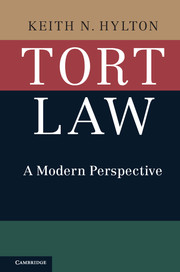Book contents
- Frontmatter
- Contents
- 1 Introduction
- 2 Policy and Tort Law
- 3 Evolution of Tort Law
- 4 Intentional Torts
- 5 Theoretical Foundations of Strict Liability
- 6 The Reasonable Person
- 7 Customs, Statutes, and the Reasonable Person
- 8 Inferring Negligence
- 9 Contributory Negligence and Assumption of Risk
- 10 Contributory Negligence, Comparative Negligence, and Incentives for Care
- 11 Joint and Several Liability, and Vicarious Liability
- 12 Factual Causation
- 13 Proximate Cause
- 14 Duty to Rescue and Special Relationships
- 15 Strict Liability: Conversion, Abnormally Dangerous Activities, and Nuisance
- 16 Defamation
- 17 Products Liability
- 18 Damages
- Index
10 - Contributory Negligence, Comparative Negligence, and Incentives for Care
Published online by Cambridge University Press: 05 June 2016
- Frontmatter
- Contents
- 1 Introduction
- 2 Policy and Tort Law
- 3 Evolution of Tort Law
- 4 Intentional Torts
- 5 Theoretical Foundations of Strict Liability
- 6 The Reasonable Person
- 7 Customs, Statutes, and the Reasonable Person
- 8 Inferring Negligence
- 9 Contributory Negligence and Assumption of Risk
- 10 Contributory Negligence, Comparative Negligence, and Incentives for Care
- 11 Joint and Several Liability, and Vicarious Liability
- 12 Factual Causation
- 13 Proximate Cause
- 14 Duty to Rescue and Special Relationships
- 15 Strict Liability: Conversion, Abnormally Dangerous Activities, and Nuisance
- 16 Defamation
- 17 Products Liability
- 18 Damages
- Index
Summary
The contributory negligence rule developed early in the common law. It has been criticized for its harshness to plaintiffs and its seeming generosity to well-funded defendants, such as the railroads. Many legislatures, in response to these sentiments, enacted comparative fault statutes over the 1900s – though comparative fault developed within the common law of Georgia in the 1800s. Under comparative fault, the plaintiff is permitted to collect some percentage of his damages against a negligent defendant, even though the plaintiff is guilty of negligence too. This is different from contributory negligence, which sets the plaintiff's damages at zero whenever he is guilty of any substantial degree of negligence.
COMPARATIVE FAULT BASICS
The percentage of damages that the plaintiff is permitted to collect under comparative fault is based on an assessment of the relative fault levels of plaintiff and defendant. A court, under comparative fault, might award a plaintiff 50 percent of his damages, based on its conclusion that the plaintiff and defendant were “equally at fault” or “guilty of equal degrees of fault.”
Assessments of relative fault are not made with scientific precision. It is not clear how one would explain, in algorithmic form, the process by which a court determines the allocation of fault percentages. Some scholars have suggested mathematical algorithms. But it is unlikely that a judge, after passing the question to the jury, could determine whether the jury correctly applied a particular algorithm to assign fault percentages. It appears that courts fix fault percentages by trying to determine, after finding that both plaintiff and defendant were negligent, the degree to which each party's negligence contributed to the cause of the injury. To be sure, one could be more precise and much more rigorous in setting out a process for determining fault percentages but that would be pointless. Fault percentages are not determined by computers employing algorithms; they are determined by juries interpreting facts.
Suppose, then, that a plaintiff suffers an injury equal to $100 in an accident in which both he and the defendant were negligent. Suppose the jury determines that the plaintiff's negligence is 30 percent of the cause of the injury, and the defendant's negligence is 70 percent of the cause of the injury. Under comparative fault, the court will award the plaintiff $70 – that is, 70 percent of his damages.
- Type
- Chapter
- Information
- Tort LawA Modern Perspective, pp. 170 - 179Publisher: Cambridge University PressPrint publication year: 2016



